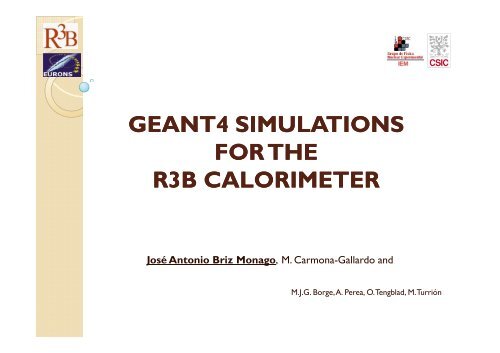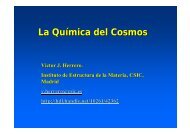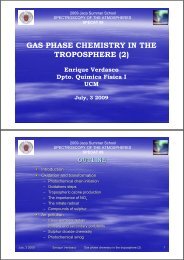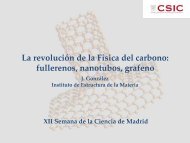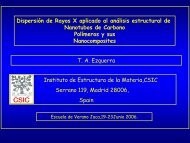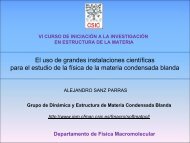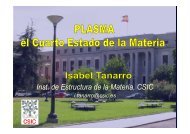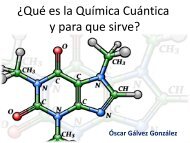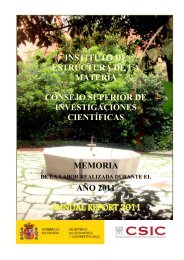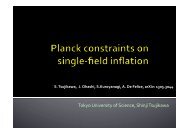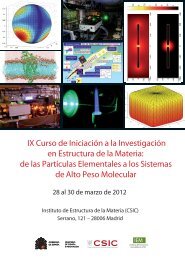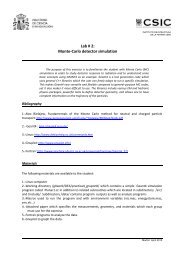GEANT4 SIMULATIONS FOR THE R3B CALORIMETER
GEANT4 SIMULATIONS FOR THE R3B CALORIMETER
GEANT4 SIMULATIONS FOR THE R3B CALORIMETER
Create successful ePaper yourself
Turn your PDF publications into a flip-book with our unique Google optimized e-Paper software.
MAGISOL meeting Madrid, January 19th 2009Outline• Introduction:FAIR at GSI (Germany)<strong>R3B</strong> ExperimentRequirements• Calorimeter: StructureForward endcap: Phoswich?• Ongoing work:Experimental testsGeant4 SimulationsFirst crystal lengthHow long must be 2nd crystal?Energy transfer to neighboring crystalsTotal Crystal’s Volume calculations• Summary and Future workGeant 4 Simulations for the R 3 B CalorimeterJosé A. Briz2
MAGISOL meeting Madrid, January 19th 2009FAIR(Facilityfor Antiprotonand IonResearch)GSI todayFuture facilityNew accelerator complex at GSI(Darmstadt, Germany) in 2012Beams of stable and radiactivenuclei and antiprotonsHigher beam intensities: 1012ions/s at 2-30 GeV/uNUSTAR(Nuclear STructure, Astrophysics and Reactions)R 3 B experimentGeant 4 Simulations for the R 3 B CalorimeterJosé A. Briz3
MAGISOL meeting Madrid, January 19th 20093R 3 B Experiment(Reactionswith RelativisticRadiactiveBeams)Studies of reactions in inverse full kinematicsReactions to be considered in <strong>R3B</strong> experiment:• Elastic and quasi-elastic scattering• Coulomb excitation• Knockout reactions• Total-absorption and charge-exchange reactions• Fission and spallation• Fragmentation and multifragmentationGeant 4 Simulations for the R 3 B CalorimeterCalorimeter: CALIFAJosé A. Briz4
MAGISOL meeting Madrid, January 19th 2009CALIFA’s StructureBased on angular distribution of emitted γ rays and its corresponding Doppler shift(because of γ rays sources are moving with relativistic energies).◦ Barrel: Region from ~40º up to 130º in polar angles◦ Forward endcap: From ~ 7º up to ~40ºGeant 4 Simulations for the R 3 B CalorimeterJosé A. Briz6
MAGISOL meeting Madrid, January 19th 2009Forward endcap: Phoswich?• Contribute to design of CALIFA's forward endcap. In principle, we’ll record:◦ γ-rays in the energy region 50 keV - 25MeV (~50% of total γ-rays emitted by a moving source)◦ Protons up to 300 MeV in Lab system• Our suggestion: two new generation scintillators crystals layers in a phoswichconfiguration with only one common readout (crystals must be optically compatibles).◦ For protons: useful for particle telescope ∆E/E identification: solve ambiguityDeposited energy by a charged particle in amaterial according to Bethe-Bloch equation◦ For gammas: energy and efficiency optimization at reduced costGeant 4 Simulations for the R 3 B CalorimeterJosé A. Briz7
MAGISOL meeting Madrid, January 19th 2009Experimental tests• Phoswich: h LB LaBr 3 (3 cm) + LaCl 3 (5 cm)MaterialEnergy Resolution(at 662 keV) (%)Light yield(photons/keV γ)Decay time (ns)LaBr 3 2.9 63 16LaCl 3 3.8 49 28ST. GOBAIN PHOSWICHHAMAMATSU R5380 PMTENERGY SPECTRUM WITH GATE APHOSWICH ENERGY SPECTRUM FWHM 6.27%at 662 keVTEMPORAL SPECTRUMENERGY SPECTRUM WITH GATE BFWHM 4.41%41%at 662 keVGeant 4 Simulations for the R 3 B CalorimeterJosé A. Briz8
MAGISOL meeting Madrid, January 19th 2009Crystals optimization: simulations• Geant4 simulations purposes◦ Comparison with experimental tests in our Lab◦ Search for the best material and size of each crystal (following CALIFA’srequirements)◦ Analysis of energy transfer to the neighboring crystals: very important forelectronic components (coincidences and summing)First configuration analyzed is:• LaBr 3 in a 3x3 array.• 20x20 mm 2 frontal surface of each crystal• Total energy deposited (9 crystals)• Gamma-rays from 500 keV up to 30 MeV• Incidence on central crystal• Distance source-detector = 20 cmGeant 4 Simulations for the R 3 B CalorimeterJosé A. Briz9
MAGISOL meeting Madrid, January 19th 2009First crystal length• Studying first interaction depth for LaBr 3 : we need to makesurethat gammaparticles interact in first crystal100First hit depth90e(%)Incident part ticle percentag807060504030200,5 MeV1 MeV2 MeV5 MeV10 MeV20 MeV30 MeVGeant 4 Simulations for the R 3 B Calorimeter100 1 2 3 4 5 6 7 8 9 10 11 12 13 14 15 16 17 18 19 20Depth (cm)With 7 cm length we get 70% (at least) incidentparticles have been detected. Probably is a goodelection for first crystal lengthJosé A. Briz10
MAGISOL meeting Madrid, January 19th 2009How long must be 2 nd crystal?• Studying Photopeak efficiency100Photopeak efficiency (90%) with respect to crystal length908070)Efficiency (%)60504030201000.5 MeV1 MeV2 MeV5 MeV10 MeV20 MeV30 MeV0 1 2 3 4 5 6 7 8 9 10 11 12 13 14 15 16 17 18 19 20Depth (cm)From 15 cm of LaBr 3 practically efficiency don´timprove: a hint about total phoswich h lengthGeant 4 Simulations for the R 3 B CalorimeterJosé A. Briz11
MAGISOL meeting Madrid, January 19th 2009Energy transferto neighboring cristals◦ Photopeak efficiency (90% initial energy deposited)opeak Efficiency (% %)Phot10090807060504030201003x3 Array LaBr30.5 MeV 1 MeV2 MeV 5 MeV10 MeV 20 MeV30 MeV0 2 4 6 8 10 12 14 16 18 20Photo opeak Efficiency (% %)10090807060504030201005x5 Array LaBr30.5 MeV 1 MeV2 MeV 5 MeV10 MeV 20 MeV30 MeV0 2 4 6 8 10 12 14 16 18 20Depth (cm)Depth (cm)◦ Better photopeak efficiencies for 5x5 array (about 5 % for 7 cm length)◦ Next tests: compare results for 5x5 with 7x7Geant 4 Simulations for the R 3 B CalorimeterJosé A. Briz12
MAGISOL meeting Madrid, January 19th 2009Total Crystal’s sVolume• Total Crystal’s Volume: Variation with respect to inner radius analysis• At present, inner radius in barrel is stablished to be 300 mmlumeTotal vol(barrel + forwar rd end cap)with respect to volum me for r i =300mm)( %Total volume’s variation with respect toinner radius110100908070605040302010050 100 150 200 250 300 350inner radius (mm)300mm200mmReduction of number ofcrystals as well as# of readout channels• If we reduce inner radius to 200 mm, volume of detector material used isabout 50 % (with the samecrystal tllength)Geant 4 Simulations for the R 3 B CalorimeterJosé A. Briz13
MAGISOL meeting Madrid, January 19th 2009Summary• Necessary to sum more neighboring crystals(as shown 5x5 better efficiency than 3x3)• Phoswich dimensions: two crystals 7 + 8 [cm] or one crystal 15 cm• Transmit to the rest of collaboration:small reduction of inner radius = big reduction of cost(# crystals as well as # readout channels)Future work• Perform simulations with protons• Introduce real dimensions of crystals• Implementation of LITRANI code for creation and propagation ofscintillation photons to obtain realistic spectra with energy resolution ofcrystalsGeant 4 Simulations for the R 3 B CalorimeterJosé A. Briz14
egionale. Tale comunicazione deve essere firmata dal rappresentante legale o suo delegato per l’attività. Inallegato alla comunicazione deve essere fornito il calendario dettagliato delle attività previste, specificando:per attività formative di tipo formale:• i giorni di attività e orari, redatti su base settimanale o mensile; in caso di attività non continuativa ilcalendario dovrà indicare i singoli giorni e i relativi orari di ogni lezione;• gli argomenti;• l’elenco nominativo delle figure professionali impegnate nelle attività caratteristiche del progetto(docenti, codocenti, tutor, coordinatore e direttore), corredato dai relativi curricula sottoscrittiqualora non siano stati presentati precedentemente;• la sede di svolgimento e quella in cui sono conservati i documenti di registrazione delle attività;• elenco nominativo degli allievi;per attività formative di tipo non formale:• il periodo di realizzazione;• il contenuto dell’attività;• l’elenco nominativo delle figure professionali impegnate;• la sede di svolgimento e quella in cui sono conservati i documenti di registrazione delle attività;• l’elenco dei partecipanti.L’orario giornaliero non può superare le sei ore in caso di orario continuato o le otto ore in caso di orariospezzato. L’attività formativa non può iniziare prima delle ore 8 e non può terminare oltre le ore 23.00; nonpuò inoltre svolgersi in giorni festivi (salvo autorizzazione dell’amministrazione erogante il finanziamento)ed il relativo orario settimanale non potrà superare le 40 ore.Nel caso di stage, il soggetto attuatore è tenuto, prima dell’avvio delle attività relative, a stipulare con ilsoggetto ospitante una convenzione, che deve contenere i seguenti elementi:- la tipologia e le modalità dello stage (durata, frequenza, orario);- il nominativo del partecipante e le mansioni attribuite;- i diritti e gli obblighi delle parti;- il nominativo del tutor del soggetto attuatore e del tutor aziendali.La convenzione deve essere conservata dal soggetto attuatore.Il soggetto attuatore è obbligato ad informare preventivamente il competente ufficio INAIL e l’Ispettoratodel Lavoro dell’inizio dello stage, nel rispetto dei tempi indicati nella normativa vigente.b – Incompatibilità tra funzioni professionaliPer lo svolgimento delle funzioni previste da parte di personale esterno/interno al soggetto attuatore deveessere predisposto apposito incarico/ordine di servizio in forma scritta.Non possono essere assegnate alla stessa persona funzioni di controllo e funzioni operative.E’ possibile, quindi, assegnare ad una stessa persona più funzioni nell’ambito di un progetto purchécompatibili tra loro per compiti, per tempi di svolgimento, per professionalità necessarie.Di norma, l’incompatibilità ricorre per le funzioni di docenza e tutoring, di coordinamento e tutoring, e,salvo casi eccezionali, di coordinamento/direzione e docenza, poiché in tali casi si determinerebbe l’assenzadella necessaria distinzione tra funzioni di controllo e operative.A.8 Registrazione delle attivitàa - Registri didatticiIl soggetto attuatore è obbligato alla tenuta di registri che costituiscono un supporto fondamentale per icontrolli didattici e amministrativo-contabili.15


